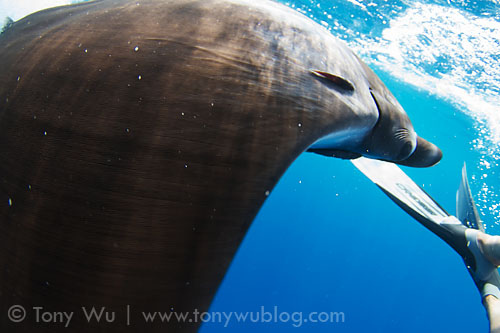I just received more feedback relating to my baffling experience of being rammed by a manta ray.
One of the people I wrote to was kind enough to post a link to my story on the Elasmo-L discussion list, and another person was nice enough to forward a couple of the responses (Thanks David, Lydie!).
The two responses are from Dr. Giuseppe Notarbartolo di Sciara (President, Tethys Research Institute) and Dr. Samuel H Gruber (University of Miami Rosenstiel School of Marine and Atmospheric Sciences and Bimini Biological Field Station).
With permission from both researchers, I'm posting their comments below (unedited except removal of cc: lists and email addresses) because they mention instances in which sounds may have been made by other rays, specifically eagle rays and cownose rays.
One description in particular cited by Giuseppe struck a chord, as it closely describes what I heard: "one or more loud, sharp clicks, commonly in pairs and sometimes in longer trains resembling scrapes".
I realise none of this proves that rays can make sounds, but it's comforting to know that I may not be the only person who's hearing things.

Manta ray after hitting me. Those are my feet and fins.
From: Samuel H Gruber
Sent: Tuesday, 19 April 2011 13:05
To: Giuseppe Notarbartolo di Sciara; David Shiffman
Subject: Re: [Elasmo-L] Do manta rays vocalize?
Hi Tony: Phil Lobel and Valentina de Santo have been collaborating with me to see if indeed eagle rays produce sounds. At the moment we are trying to develop on-board recording devices combined with acoustic transmitters. A decade ago we did a couple of papers on eagle ray social behavior and ethology.
M. J. Corcoran and S. H. Gruber 1999. The use of photoidentification to study social organization of the spotted eagle ray, Aetobatus narinari (Euphrasen 1790), at Bimini, Bahamas: a preliminary report. Bahamas J. Sci. 7(1):21-27
W. R. Silliman & S.H. Gruber. 1999. Behavioral biology of the spotted eagle ray, Aetobatus narinari (Euphrasen, 1790), in Bimini, Bahamas; an interim report. Bahamas J. Sci. 7(1): 13-20
Our goal was to investigate possible bioacoustics in A. narinari. We were prompted by cinematographer Pete Zuccarini who like you had recorded what he thought were high pitched whistles in the vicinity of eagle rays he was filming. So a decade later we are revisiting this question (if we can develop the hardware). But as Dr. Notobarlo di Sciara noted, I found it very interesting that another (captive) relative, the cownose ray was said to produce sounds when prodded.
As for comments about mantas not producing sounds or attacking: Remember you can never prove a negative. I agree with keeping an open mind as well as healthy skepticism. Not that much is known about young mantas (which are related to eagle and cownose rays) or their behavior or physiology probably due to their size and difficulty of study. I can imagine a scenario where young mantas might have evolved an antipredator suite which includes intense sound and aggressive head butting behavior to ward off predators such as sharks. Sharks are particularly sensitive to intense low frequency sounds in the range of 100-1000 Hz. Juveniles of the huge rays might be perfectly good prey for larger sharks and having such an hypothetical antipredator suite could be of great survival value.
The work continues....
doc
Dr. Samuel H. Gruber
Division of Marine Biology and Fisheries
Rosenstiel School of Marine and Atmospheric Sciences
University of Miami 33149-1098
and
Bimini Biological Field Station
9300 SW 99 St
Miami FL 33176-2050
http://www.miami.edu/sharklab
----- Original Message -----
From: Giuseppe Notarbartolo di Sciara
To: David Shiffman
Sent: Monday, April 18, 2011 9:15 AM
Subject: Re: [Elasmo-L] Do manta rays vocalize?
David,
To the best of my knowledge, elasmobranchs are amongst the least loquacious of marine vertebrates, and the only reference to elasmobranch "vocalizations" to the best of my knowledge comes from Fish and Mowbray's 1970 account of cownose rays emitting, after having been strongly prodded, "one or more loud, sharp clicks, commonly in pairs and sometimes in longer trains resembling scrapes, ... ". No vocalizations have ever been noted in any mobulid.
This said, my policy when faced with the unknown is usually one of humility and open-mindedness. Mobulids are rarely kept in captivity, and vocalizations from the more common cownose rays might be easier to detect. I would be surprised to learn that mantas make noises, and would be at a loss imagining what would they make noises with. However, mantas are surprising animals, with exceedingly large brains which may serve social functions, and these in turn could be mediated by sound. My best advice to divers and scientists is, keep your ears (and minds) open.
Best,
Giuseppe